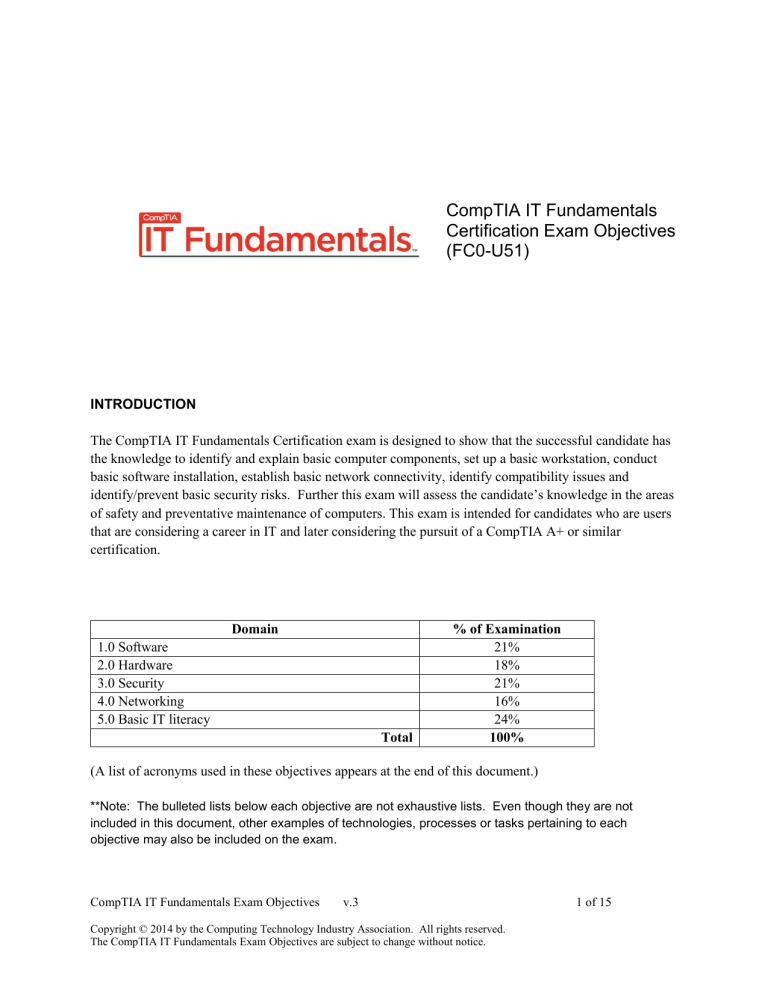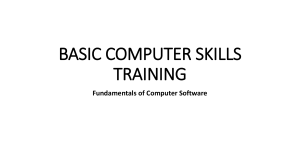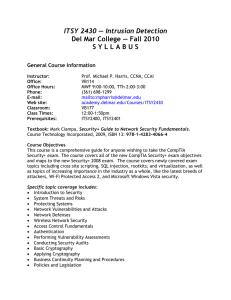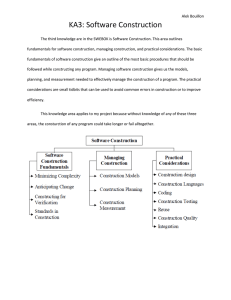
CompTIA IT Fundamentals Certification Exam Objectives (FC0-U51) INTRODUCTION The CompTIA IT Fundamentals Certification exam is designed to show that the successful candidate has the knowledge to identify and explain basic computer components, set up a basic workstation, conduct basic software installation, establish basic network connectivity, identify compatibility issues and identify/prevent basic security risks. Further this exam will assess the candidate’s knowledge in the areas of safety and preventative maintenance of computers. This exam is intended for candidates who are users that are considering a career in IT and later considering the pursuit of a CompTIA A+ or similar certification. Domain 1.0 Software 2.0 Hardware 3.0 Security 4.0 Networking 5.0 Basic IT literacy Total % of Examination 21% 18% 21% 16% 24% 100% (A list of acronyms used in these objectives appears at the end of this document.) **Note: The bulleted lists below each objective are not exhaustive lists. Even though they are not included in this document, other examples of technologies, processes or tasks pertaining to each objective may also be included on the exam. CompTIA IT Fundamentals Exam Objectives v.3 Copyright © 2014 by the Computing Technology Industry Association. All rights reserved. The CompTIA IT Fundamentals Exam Objectives are subject to change without notice. 1 of 15 1.0 Software 1.1 Compare and contrast common Operating Systems and their functions and features Types o Mobile Apple iOS Android Windows Phone Blackberry o Workstation Windows Mac Linux Chrome OS o Open source vs. commercial Software compatibility for different OS types and versions Awareness of hardware compatibility for OS support o 32bit vs. 64bit operating systems Basic functions of an operating system o Interface between user and machine o Coordination of hardware components o Provides environment for software to function o Monitors system health and functionality o Displays structure / directories for data management 1.2 Identify common programs, applications and their purpose Types o Productivity Software Word processing Spreadsheet software Email software Basic database software PDF viewers/creators Presentation software Desktop publishing software Personal Information Manager Remote desktop software o Collaboration Software Online workspace Document storage/sharing Screen sharing software Video conferencing software Instant messaging software Email software o Utility Software Anti-malware Software firewalls Diagnostic/maintenance software Compression software CompTIA IT Fundamentals Exam Objectives v.3 Copyright © 2014 by the Computing Technology Industry Association. All rights reserved. The CompTIA IT Fundamentals Exam Objectives are subject to change without notice. 2 of 15 o Specialized Software CAD Graphic design Medical Scientific Financial Gaming Entertainment o Open source vs. commercial Platforms o Mobile o Desktop o Web-based Common file types o Documents txt rtf doc/docx xls/xlsx ppt/pptx pdf o Audio mp3 wav flac aac m4a o Images jpg gif tiff png bmp o Video mpg mp4 flv wmv avi o Executables exe msi app bat scexe o Compression formats rar tar zip dmg iso CompTIA IT Fundamentals Exam Objectives v.3 Copyright © 2014 by the Computing Technology Industry Association. All rights reserved. The CompTIA IT Fundamentals Exam Objectives are subject to change without notice. 3 of 15 7zip / 7z gzip / gz jar 1.3 Given a scenario, use software management best practices Install / uninstall o OS features o Applications o Drivers Patching / updates for OS, drivers, applications and security software o Scheduling o Frequency o Automatic updates Software version identification and compatibility Licensing o Product keys o Single / multi-license 1.4 Identify the following alternative technologies and their purpose Virtualization o Physical machine vs. virtual machine Cloud Computing o Streaming media (audio/video) Web applications VoIP Telepresence Gesture-based interaction o Swiping o Pinch-to-zoom o Kinetics 1.5 Explain the basic software features and functions of wireless devices Unlocking/security Bluetooth pairing o Hands free o Data transfer Wireless connection setup o Verify wireless capabilities o Turn on WiFi o Locate SSID o Enter wireless password (if applicable) o Verify internet connection Email configuration o POP3 o IMAP o SMTP Screen orientation Synchronization configuration Airplane mode Stores for mobile applications CompTIA IT Fundamentals Exam Objectives v.3 Copyright © 2014 by the Computing Technology Industry Association. All rights reserved. The CompTIA IT Fundamentals Exam Objectives are subject to change without notice. 4 of 15 2.0 Hardware 2.1 Identify basic wired and wireless peripherals and their purpose Output devices o Printer Laser Inkjet Thermal o Display devices Flatscreen CRT Projector o Speakers Input devices o Keyboard o Pointing devices Mouse Touchpad Joystick Stylus pen Trackball o Scanner o Microphone o Webcam Input & Output devices o Fax o External storage devices Flash drive External hard drive CD/DVD/Blu-Ray Network Attached Storage Memory card Mobile media players Smart phone o Touchscreen display 2.2 Compare and contrast common computer connector types Video o VGA o DVI o HDMI o Display port/Thunderbolt o USB o S-video o Component - RGB FireWire eSATA Thunderbolt USB CompTIA IT Fundamentals Exam Objectives v.3 Copyright © 2014 by the Computing Technology Industry Association. All rights reserved. The CompTIA IT Fundamentals Exam Objectives are subject to change without notice. 5 of 15 PS/2 Parallel Serial RJ-45 RJ-11 Audio Power o AC/DC 2.3 Identify the purpose of internal computer components CPU Power Supply RAM Storage o Optical drive o Hard drive o Solid state drive Expansion cards o Video card o Audio card o Network card o Modem Motherboard/mainboard System cooling o Case fans o CPU fans o Liquid cooling 3.0 Security 3.1 Define basic security threats Malware o Virus o Trojan o Spyware o Ransomware Phishing Social engineering Spam Password cracking Physical security o Hardware theft o Software/license theft o Shoulder surfing o Dumpster diving 3.2 Given a scenario, use security best practices Password management o Password complexity CompTIA IT Fundamentals Exam Objectives v.3 Copyright © 2014 by the Computing Technology Industry Association. All rights reserved. The CompTIA IT Fundamentals Exam Objectives are subject to change without notice. 6 of 15 o Change default passwords o Password confidentiality o Password expiration o Password reuse o Awareness of Single Sign On Device hardening o Disable unused features Disable Bluetooth Disable NFC o Timeout / lock options o Enable security software/features Software firewall Anti-malware o Encryption options Open WiFi vs. secure WiFi Multifactor authentication Suspicious emails o Attachments o Hyperlinks Act on security software alerts Admin vs. user vs. guest account 3.3 Given a scenario, use web-browsing best practices Recognize a secure connection/website o https o lock symbol Recognize invalid certificate warnings Recognize suspicious links Recognize suspicious banner ads Recognize adware symptoms o Constant popups o Home page redirection o Search engine redirection Limit the use of personal information (PII) Update browsers and plugins o Avoid use of legacy browsers Disable unneeded/suspicious browser plugins, toolbars and extensions Disable autofill forms/passwords Clear browser cache/history/cookies Recognize untrusted source warnings Risks of using public workstations CompTIA IT Fundamentals Exam Objectives v.3 Copyright © 2014 by the Computing Technology Industry Association. All rights reserved. The CompTIA IT Fundamentals Exam Objectives are subject to change without notice. 7 of 15 4.0 Networking 4.1 Given a scenario, set up and configure a basic SOHO router (wired / wireless) Verify wired connection, if applicable Set WEP vs. WPA vs. WPA2 Change SSID from default Apply a new wireless password Change admin password for router Connect to the new network Verify internet connectivity Update firmware if necessary 4.2 Compare and contrast cellular, wireless and wired data connections High vs. low mobility High vs. low availability High vs. low throughput/bandwidth High vs. low reliability Connection delay Number of concurrent connections Levels of security 4.3 Compare and contrast different methods of sharing and storage HTTP vs. HTTPS o Browser-based file downloads FTP vs. FTPS vs. SFTP (Secure File Transfer Protocol) Local vs. hosted storage o Cloud-based services Cloud-based collaborative applications Cloud-based storage o File and print sharing Workgroup Homegroup o Network drives o Network attached storage o Direct attached storage o External hard drives Peer-to-peer o Local adhoc network Bluetooth sharing o Direct link (PC-to-PC) o Online peer-to-peer network Network vs. local printing o USB o Wireless / wired network CompTIA IT Fundamentals Exam Objectives v.3 Copyright © 2014 by the Computing Technology Industry Association. All rights reserved. The CompTIA IT Fundamentals Exam Objectives are subject to change without notice. 8 of 15 5.0 Basic IT literacy 5.1 Perform appropriate steps to set up a basic workstation Plug in cables Power on computer Follow initial operating system setup wizard o Localization settings o Screen resolution o Audio settings Install security software Configure peripherals (if applicable) Uninstall unneeded software (if applicable) Configure and verify internet connection Install additional software (if applicable) Run software and security updates Other user accounts (if applicable) Basic cable management 5.2 Explain the basic methods of navigating an operating system Executing programs Difference between shortcuts and files Manipulating files o Open o Edit o Save o Move o Copy o Cut o Paste o Delete o Rename Read-only vs. modifiable files Navigate a file structure Search, sort and display files Create screen captures Navigate with hot keys Folder and file size Accessibility options Folder and file permissions 5.3 Given a scenario, implement basic support concepts Check for external issues o Loose cables / connections o Power o Physical damage Manufacturer documentation Manufacturer websites Technical community groups CompTIA IT Fundamentals Exam Objectives v.3 Copyright © 2014 by the Computing Technology Industry Association. All rights reserved. The CompTIA IT Fundamentals Exam Objectives are subject to change without notice. 9 of 15 Internet search engine Contact technical support 5.4 Explain basic backup concepts Importance of backups Scheduling Frequency Storage mediums o Locally attached storage o Offsite/cloud-based o Network attached storage Backup verification and testing 5.5 Describe the importance and impact of various environmental and safety concepts Proper disposal methods o RoHS o CRT monitors o Scanners o Batteries o Ink/toner o Hard drives Power o Energy efficient devices o Power profiles Power options Sleep / hibernation o UPS vs. surge protector vs. power strip Power limitations o International power differences Device placement o Airflow o Humidity o Temperature o Dust accumulation o EMI Electrostatic discharge concepts Ergonomic concepts o Proper keyboard and mouse placement o Sitting positions o Monitor level placement Follow manufacturer safety guidelines CompTIA IT Fundamentals Exam Objectives v.3 Copyright © 2014 by the Computing Technology Industry Association. All rights reserved. The CompTIA IT Fundamentals Exam Objectives are subject to change without notice. 10 of 15 CompTIA Strata Acronyms Introduction The following is a list of acronyms which appear on the CompTIA Strata IT Fundamentals exam. Candidates are encouraged to review the complete list and attain a working knowledge of all listed acronyms as a part of a comprehensive test preparation program. ACRONYM AC BD-ROM BIOS CAD CAM CD CD-ROM CD-RW CPU CRT DC DDR DDR RAM DDR SDRAM DHCP DIMM DNS DSL DVD DVD-DL DVD-R DVD-RAM DVD-ROM DVD-RW DVI EMI EMP eSATA ESD FAT FAT32 FTP FTPS Gb SPELLED OUT Alternating Current Blu-Ray Read Only Memory Basic Input/Output System Computer Aided Design Computer Aided Manufacturing Compact Disc Compact Disc-Read-Only Memory Compact Disc-Rewritable Central Processing Unit Cathode-Ray Tube Direct Current Double Data-Rate Double Data-Rate Random Access Memory Double Data-Rate Synchronous Dynamic Random Access Memory Dynamic Host Configuration Protocol Dual Inline Memory Module Domain Name Services or Domain Name Server Digital Subscriber Line Digital Video Disc or Digital Versatilve Disc Digital Video Disc or Digital Versatilve Disc Dual Layer Digital Video Disc-Recordable Digital Video Disc-Random Access Memory Digital Video Disc-Read Only Memory Digital Video Disc-Rewritable Digital Visual Interface Electromagnetic Interference Electromagnetic Pulse External Serial Advanced Technology Attachment Electrocstatic Discharge File Allocation Table 32-bit File Allocation Table File Transafer Protocol File Transfer Protocol over Secure Sockets Layer Gigabit CompTIA IT Fundamentals Exam Objectives v.3 Copyright © 2014 by the Computing Technology Industry Association. All rights reserved. The CompTIA IT Fundamentals Exam Objectives are subject to change without notice. 11 of 15 GB GHz GPS HDD HDMI HTML HTTP HTTPS IDE IMAP IP IR ISDN ISP Kb KB LAN MB Mb MHz MIDI MP3 MP4 MPEG NAS NFC NIC OEM OS PC PCI PCIe PCIX PII POP POP3 POTS PSU PS/2 RAM RGB RJ RJ-11 Gigabyte Gigahertz Global Postioning System Hard Disk Drive High Definition Media Interface Hypertext Markup Language Hypertext Transfer Protocol Hypertext TRAnsfer Protocol over Secure Sockets Layer Integrated Drive Electronics Internet Mail Access Protocol Internet Protocol Infrared Integrated Services Digital Network Internet Service Provider Kilobit Kilobyte or Knowledge Base Local Area Network Megabyte Megabit Megahertz Musical Instrument Digital Interface Moving Picture Experts Group Layer 3 Audio Moving Picture Experts Group Layer 4 Moving Picture Experts Group Network Attached Storage Near Field Communications Network Interface Card Original Equipment Manufacturer Operating System Personal Computer Peripheral Component Interconnect Peripheral Component Interconnect Express Peripheral Component Interconnect Extended Personally Identifiable Information Post Office Protocol Post Office Protocol 3 Plain Old Telephone System Power Supply Unit Personal System 2 Random Accesss Memory Red-Green-Blue Registered Jack Registered Jack Function 11 CompTIA IT Fundamentals Exam Objectives v.3 Copyright © 2014 by the Computing Technology Industry Association. All rights reserved. The CompTIA IT Fundamentals Exam Objectives are subject to change without notice. 12 of 15 RJ-45 RoHS SATA SD card SFTP SID SMTP SOHO SSD SSID SSL TB TCP TCP/IP UPS URL USB VGA VoIP VTC WAN WAP WEP WIFI WiMAX WLAN WPA WPA2 WPS Registered Jack Function 45 Recycling of Hazardous Substances Serial Advanced Technology Attachment Secure Digital Card Secure File Transfer Protocol System Identifier Simple Mail Transfer Protocol Small Office / Home Office Solid State Drive Service Set Identifier Secure Sockets Layer Terabyte Transmission Control Protocol Transmission Control Protocol / Internet Protocol Uninterruptable Power Supply Uniform Resource Locator Universal Serial Bus Video Graphics Array Voice over Internet Protocol Video Teleconference Wide Area Network Wireless Application Protocol Wired Equivalency Privacy Wireless Fidelity Worldwide Interoperability for Mircowave Access, Inc. Wireless Local Area Network Wireless Protected Access Wireless Protected Access 2 Wireless Protected Setup Version 1.0 CompTIA IT Fundamentals Exam Objectives v.3 Copyright © 2014 by the Computing Technology Industry Association. All rights reserved. The CompTIA IT Fundamentals Exam Objectives are subject to change without notice. 13 of 15 Suggested Classroom Equipment to have for IT Fundamentals Certification Training Equipment Workstations – unpackaged workstations Unconfigured OS images Wireless router Workstation with virtualization software Laptop Basic printer External storage devices Tablet/smart phone Power strip/UPS Spare parts/hardware Blank CDs/DVDs (for backup) Various cable types Tools ESD wrist band (for demonstration) Software Operating system media Anti-malware software Productivity software Browser software Backup software Other CompTIA IT Fundamentals Exam Objectives v.3 Copyright © 2014 by the Computing Technology Industry Association. All rights reserved. The CompTIA IT Fundamentals Exam Objectives are subject to change without notice. 14 of 15 N/A CompTIA IT Fundamentals Exam Objectives v.3 Copyright © 2014 by the Computing Technology Industry Association. All rights reserved. The CompTIA IT Fundamentals Exam Objectives are subject to change without notice. 15 of 15





